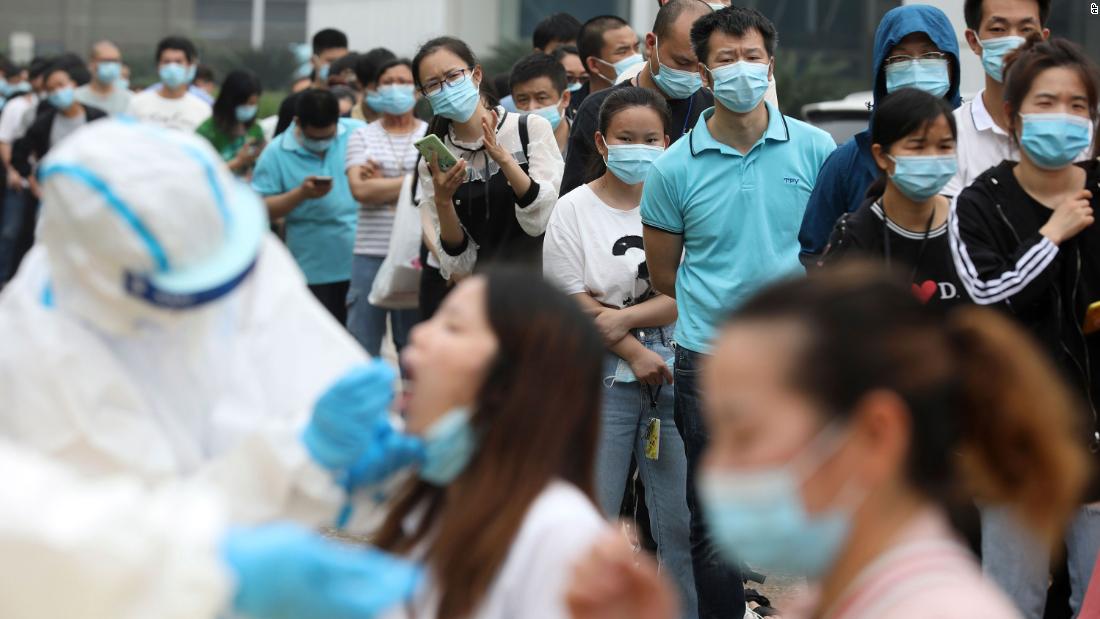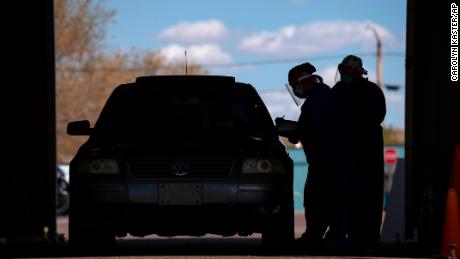Here’s what pooled testing is and how it can be used for the coronavirus
It isn’t feasible to continually test everyone at a whole test per person. There simply aren’t enough resources and supplies.
But pool testing, under the right circumstances, could ultimately involve fewer tests and supplies, yet cover many more people than are tested now.
“Pooling would give us the capacity to go from half a million tests per day to potentially 5 million individuals tested per day,” Dr. Deborah Birx, a White House coronavirus task force official, told the American Society for Microbiology last month.
Here is a closer look:
How does pool testing work?
At a basic level, this is pool testing:
Say a lab has collected samples — like those collected from nasal swabs — from five people. The lab will take a portion from each sample and mix those portions together, creating a pool.
Now, one diagnostic test will be run on that pooled sample, instead of five diagnostic tests on five samples.
“If the pooled sample comes back positive, then each sample needs to be tested individually to find out which was positive.
“Because samples are pooled together, ultimately fewer tests are run overall, meaning fewer testing supplies are used.”
Experts say there are ways to mitigate that risk, which we will explore further below.
Is this for the general population, or more narrow groups, like schools and factories?
A lot will depend on circumstances, needs and imagination.
First, know this: Pool testing should be done only where prevalence of the disease is low, according to Eugene Litvak, adjunct professor of operations management at Harvard University’s school of public health.
That is, pool testing should be done where you’d expect a lot of negative results and you’re just trying to catch the few cases that may be out there, Litvak and other experts say.
To put it roughly, there’s no point pool testing somewhere that already has a lot of cases, such as a nursing home with multiple positive patients. Virtually every pool would turn up positive; you might as well have tested everyone individually.
Having said that, there are a lot of places where pool testing could make sense, according to Juthani and other experts:
• Communities where Covid-19 isn’t prevalent
One scenario would be pool testing in communities that just had their first Covid-19 hospitalizations, Birx said in her June 22 address to the ASM.
The goal would be to find infected people — especially those who may be spreading the disease without showing symptoms — and isolate them before the spread worsens, Birx said.
• Neighborhoods that need to be assessed in an outbreak
In this scenario, an entire family could be part of one pool, Juthani said.
• Schools, universities and large employers
Pool testing could be a key tool for schools, organizations or workplaces that want to stay open safely, by monitoring their people periodically.
“If one wing of a dorm, or one classroom in a school, is a pool and tested all together, that group could be cleared quickly,” Juthani said.
That’s because if days elapse, you’ve potentially allowed an infected person to spread the disease while waiting.
Labs’ use of robotics is necessary, both for speed, and to keep track of pools and samples, Litvak told CNN.
Such robotics have existed for decades, said Litvak, who added he “would be surprised if (capacity in the US) is a problem.”
What is the history of pool testing, and where is it being done now?
Some countries already have been using pool testing for the coronavirus pandemic.
“If you look around the globe, the way people are doing a million tests or 10 million tests is they’re doing pooling,” Birx said last month.
Resource-limited countries with limited test availability and low disease prevalence, such as Rwanda, also have used pool testing well, Juthani said.
How many people’s samples could be in one pool?
But US health officials generally have been talking about pools of lower numbers. Birx has spoken of pools of five or greater.
Generally speaking, the greater the disease’s prevalence in a population, the smaller your pools have to be, Litvak said.
How does this work out to fewer tests overall?
If a pool test is positive, yes, you have to test everyone individually. So, under the basic procedure, you will have run one more test (the pool test) than you would have, had you just decided to test everyone individually from the start.
But, that’s why pool testing should be done in populations where the disease isn’t believed to be widespread. Under those circumstances, you presumably clear a lot of people with just one test.
Juthani gives this example under the basic procedure: Presume you take 100 people, and break them into 20 pools of five. Now presume a prevalence rate of just 5%, meaning there will be five true positives out of 100.
If each one of the five positives turns up in a separate pool, five of your 20 pools are positive.
So, you ran 20 pool tests, and because of the five pool positives, you have to additionally test 25 individuals.
That’s 45 diagnostic tests, versus 100 diagnostic tests had you tested each individual separately from the beginning.
It gets inefficient if the prevalence rate is high. If there were 30 true positives in your group of 100, all of your 20 pools of five may have at least one positive sample. If all pools test positive, you need to test all individual samples — so now you’ve run 120 tests (20 pool and 100 individual), which is a waste of time and resources.
How do you guard against false negatives?
Pool samples could be tested twice, for greater confidence, Juthani says.
In that situation, using one of the scenarios above (5% prevalence; 100 subjects; 20 pool tests), you’d have:
• 20 initial tests
• 15 to 20 confirmatory tests (because five should be positive at some point)
• 25 individual tests because of the five positive pools.
You would have spent 60 to 65 tests — still fewer than the 100 you’d otherwise have done individually.
Other issues could lead to false negatives, including poor specimen collection, or poor tests with low specificity, Juthani says.
Split-pool testing is:
1) Test a pool — say, it’s eight people — twice. If the pool is negative twice, then clear everyone.
2) If the pool tests positive either time, then, split the pool in half, and then test both halves twice. In this example, create two pools of four, and test each pool twice.
3) Clear any pool that was negative. If either pool of four tests positive, split that pool again — two pools of two, and repeat, until you’re down to individual tests.
This still will result in fewer tests than going straight to individual testing, assuming low prevalence. And, because this protocol whittles down the eventual number of individual tests needed, it can even yield fewer tests than simple pooled testing.
Split-pool testing should be the preferred protocol, he said.
“Given the urgent need for large-scale testing in the US and limited resources, the right pooled testing protocol becomes a priority,” he said.
CNN’s Jacqueline Howard, Amanda Watts and Lauren Mascarenhas contributed to this report.
![]()










